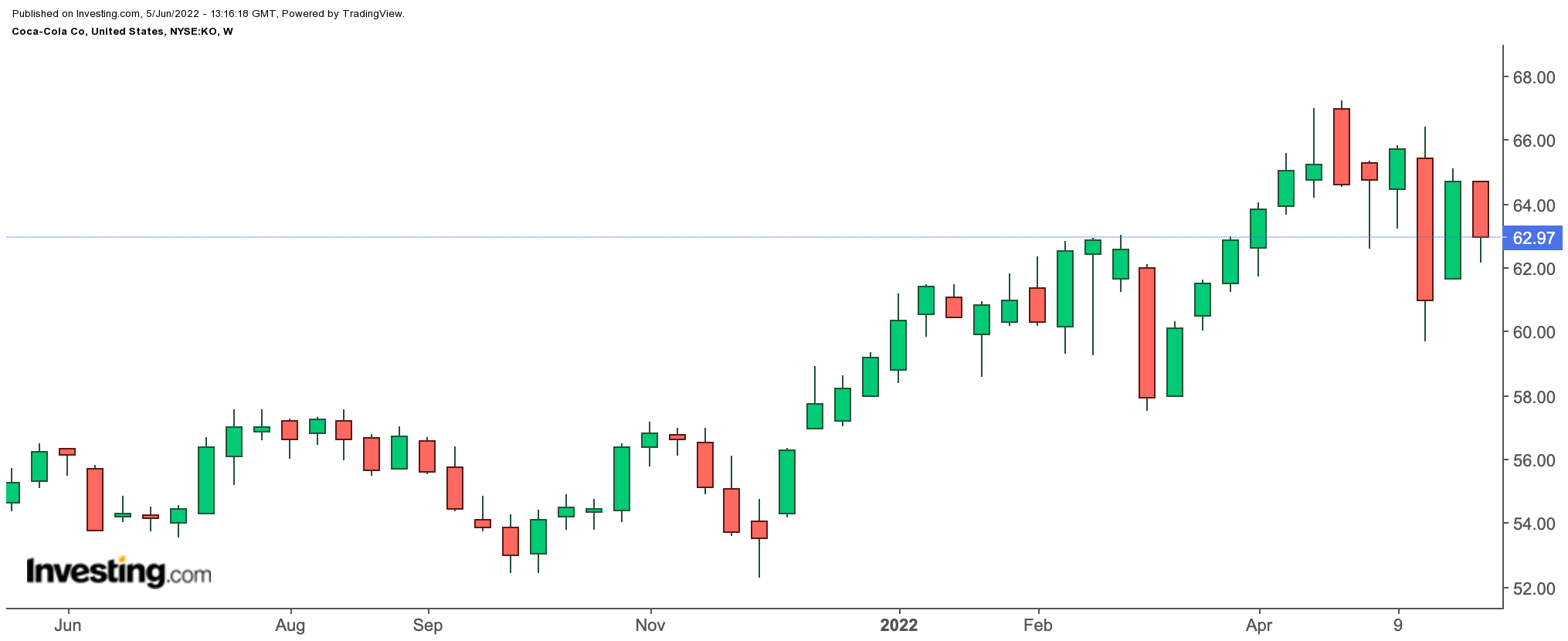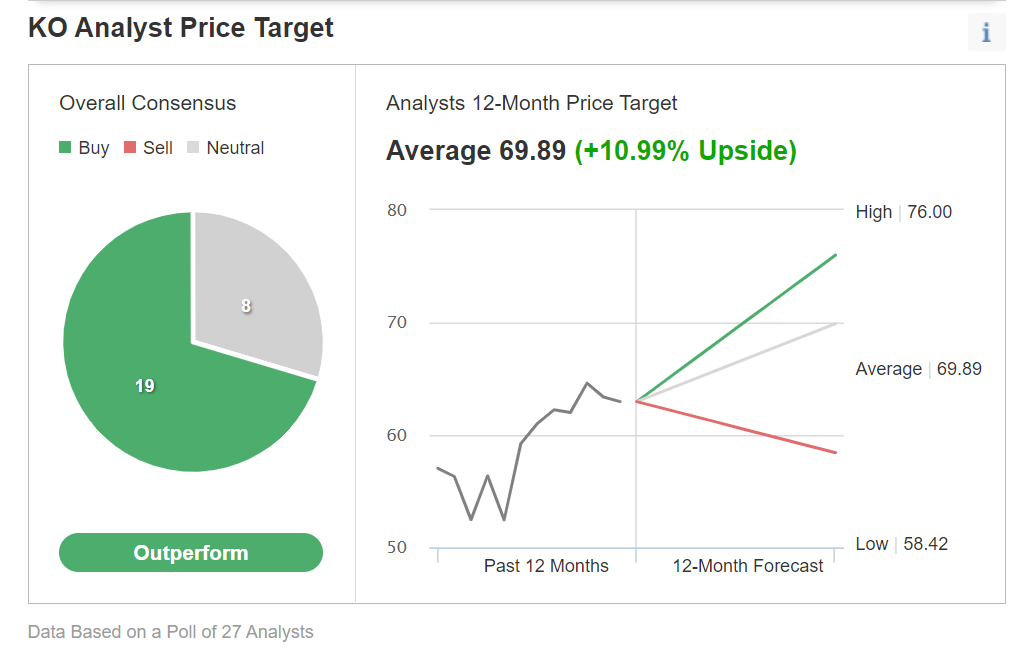- Shares of KO, the largest nonalcoholic beverage company of the world, are up over 6% since the beginning of 2022.
- Despite inflationary headwinds, the beverage giant forecasts 7-8% revenue growth in 2022, in part thanks to its strong pricing power.
- Long-term investors could consider buying KO shares at current levels.
- For tools, data, and content to help you make better investing decisions, try InvestingPro+.
- iShares Evolved U.S. Consumer Staples ETF (NYSE:IECS)
- Consumer Staples Select Sector SPDR® Fund (NYSE:XLP)
- WBI BullBear Quality 3000 ETF (NYSE:WBIL)
- Invesco Dynamic Food & Beverage ETF (NYSE:PBJ)
- WisdomTree U.S. High Dividend Fund (NYSE:DHS)
Shareholders of soft drink behemoth Coca-Cola (NYSE:KO) have seen the value of their investment go up by almost 12.0% over the past 52 weeks and 6.4% year-to-date. In comparison, shares of its biggest rival, PepsiCo (NASDAQ:PEP), have dropped 5.1% so far in 2022. Meanwhile, the Dow Jones US Soft Drinks Index is down 0.3%.

A bit more than a month ago, on Apr. 25, KO shares pushed past $67, hitting a record high. The stock’s 52-week range has been $52.28-$67.20, while the market capitalization (cap) currently stands at $272.9 billion.
Recent Metrics
Coca-Cola’s share of the soft drinks market in the US is close to 45%. As well, the Atlanta-based company ranks among the top 100 on the Fortune 500 list.
The beverage leader issued Q1 figures on Apr. 25. Revenue grew 18% year-over-year (YoY) and reached $10.5 billion. Meanwhile adjusted EPS increased 16% YoY to 64 cents. However, free cash flow was about $400 million, a decline of $1.0 billion from a year ago.
Management noted that:
“The company gained value share in total nonalcoholic ready-to-drink (NARTD) beverages, which included share gains in both at-home and away-from-home channels.”
For 2022, Coca-Cola expects to deliver 7-8% organic revenue growth and EPS growth of 5-6%.
Prior to the release of its Q1 results, KO stock was around $67.00. But on June 3, it closed at $62.97.
What To Expect From KO Stock
Among 27 analysts polled via Investing.com, KO stock received an "outperform" rating.

Source: Investing.com
Wall Street also has a 12-month median price target of $69.89 for the stock, implying an increase of almost 11% from current levels. The 12-month price range currently stands between $58.42 and $76.00.
However, according to a number of valuation models, like those that might consider P/E or P/S multiples or terminal values, the average fair value for KO stock at InvestingPro stands at $64.24.
In other words, fundamental valuation suggests shares could only increase about 2.0%.
We can also look at KO’s financial health as determined by ranking more than 100 factors against peers in the consumer staples sector.
For instance, in terms of profit and price momentum, it scores 4 out of 5. Its overall score of great points is a good performance ranking.
At present, KO’s P/E, P/B, and P/S ratios are 26.5x, 11.0x, and 6.8x. Comparable metrics for peers stand at 28.3x, 4.8x, and 2.8x. These numbers show that despite the recent decline in price, the fundamental valuation for KO stock is still on the rich side.
Our expectation is for KO stock to build a base between $60 and $63 in the coming weeks. Afterwards, shares could potentially start a new leg up.
Adding KO Stock To Portfolios
Coca-Cola Company bulls who are not concerned about short-term volatility could consider investing now. Their target price would be $64.24, as suggested by quantitative measures.
Alternatively, investors could consider buying an exchange-traded fund (ETF) that has KO stock as a holding. Examples include:
Finally, investors who expect KO stock to bounce back in the weeks ahead could consider setting up a bull call spread.
Most option strategies are not suitable for all retail investors. Therefore, the following discussion on KO stock is offered for educational purposes and not as an actual strategy to be followed by the average retail investor.
Bull Call Spread On Coca-Cola Company Stock
Price At Time Of Writing: $62.97
In a bull call spread, a trader has a long call with a lower strike price and a short call with a higher strike price. Both legs of the trade have the same underlying stock (i.e. Coca-Cola) and the same expiration date.
The trader wants KO stock to increase in price. In a bull call spread, both the potential profit and the potential loss levels are limited. The trade is established for a net cost (or net debit), which represents the maximum loss.
Today’s bull call spread trade involves buying the Sept. 16 expiry 65 strike call for $1.80 and selling the 70 strike call for $0.50.
Buying this call spread costs the investor around $1.30 or $130 per contract, which is also the maximum risk for this trade.
We should note that the trader could easily lose this amount if the position is held to expiry and both legs expire worthless, i.e., if the KO stock price at expiration is below the strike price of the long call (or $65 in our example).
To calculate the maximum potential gain, we can subtract the premium paid from the spread between the two strikes, and multiply the result by 100. In other words: ($5.00 – $1.30) x 100 = $370.
The trader will realize this maximum profit if the Coca-Cola stock price is at or above the strike price of the short call (higher strike) at expiration (or $70 in our example).
Bottom Line
In recent days, KO stock has come under pressure. Yet, the decline has improved the margin of safety for buy-and-hold investors who could consider investing soon. Alternatively, experienced traders could also set up an options trade to benefit from a potential run-up in the price of KO stock.
***
Interested in finding your next great idea? InvestingPro+ gives you the chance to screen through 135K+ stocks to find the fastest growing or most undervalued stocks in the world, with professional data, tools, and insights. Learn More »
